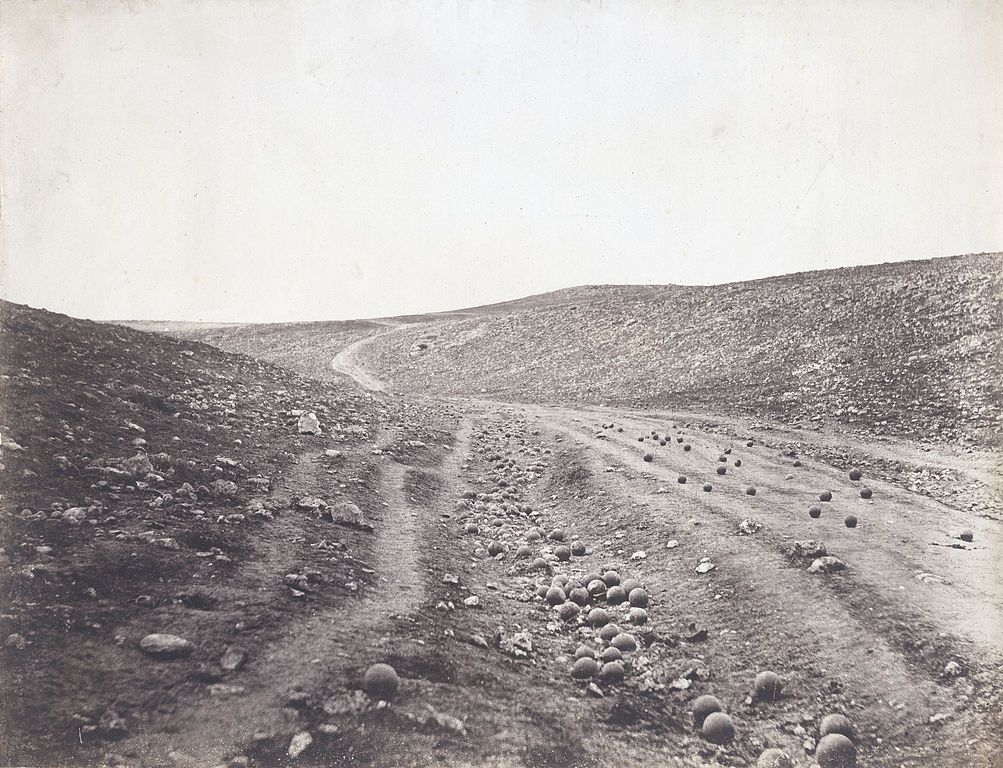Free-for-All Fakery
August 26, 2024 Computational Photography Authenticity Generative AI Google Sarah Jeong Nick Heer Potter Steward Photography Ted Chiang
“Our expectations need to change.”
When we say something is “photorealistic”, it means that whatever non-photographic image we’re looking at feels so real that it passes for a photograph. The implication, of course, is that a photo has to be real—a capture of a unique situation that actually happened, a proof of something realistic.

Roger Fenton’s famous The Valley of the Shadow of Death is an early example of a photo that might have been staged: Many accuse the photographer of having arranged the cannonballs in the picture for dramatic effect. And though there’s debate about this1 the point still stands: A photo can easily be tampered with, be it through manipulation of the subject, omission, retouching, or Photoshop. Sure, a camera achieves a more faithful reproduction than a paintbrush2, but what we see isn’t necessarily real.
When talking about authenticity, it quickly gets rather existential: What degree of faithfulness is real? Isn’t any photo, solely by being a reproduction, less real than the real thing? And why do we nevertheless tend to believe what we see in a photo?3
Google’s latest smartphones come loaded with a feature called Reimagine that allows people to edit their photos using AI: Take a picture, enter a prompt, and a few seconds later it will have generated an edit. The technology is so good that it you can comfortably call the resulting images photorealistic: There’s simply no way of telling that these images aren’t real, meaning that whatever sense of realness we used to attach to a photo goes completely out of the window.4
Sarah Jeong, reporting about this feature on The Verge puts it drastically: “We are fucked.” And yes, she too gets existential:
We briefly lived in an era in which the photograph was a shortcut to reality, to knowing things, to having a smoking gun. It was an extraordinarily useful tool for navigating the world around us. We are now leaping headfirst into a future in which reality is simply less knowable.
Earlier, she writes:
A photo (…) stops being a supplement to fallible human recollection, but instead a mirror of it. And as photographs become little more than hallucinations made manifest, the dumbest shit will devolve into a courtroom battle over the reputation of the witnesses and the existence of corroborating evidence.
The implication is clear: It’s becoming harder and harder to use photos to tell what’s real; what really happened, that is to say what configuration of people, places and _time_ took place. And since you can no longer easily tell by looking closely, we’re forced to question everything we see.
Since anyone can now radically and realistically alter an entire scene within minutes of taking a photo, our expectations need to change. But we still need to be able to believe real newsworthy photos and videos are, indeed, real.
Image manipulation is becoming so powerful and accessible that we’re quickly moving from existential concerns to very pressing ones.
Believability, not authenticity, confers power to a photo
The practical question is no longer “What are real photographs?“ but “What photos are believable?”. Ultimately it’s believability rather than authenticity that confers power to a photo.
With generative AI, it’s becoming easier every day to make images that are believable enough and therefore cause real harm. I’m thinking particularly about deepfake nudes5: Of course the (many) people making them know that the images are fake but they are believable enough to be passed around and to have caused a veritable epidemic in schools that affects very real people.
Google’s move to release the Reimagine technology—even if it can’t generate deepfake nudes!—is irresponsible but not out of character for the company. There was likely a thinking on their part that if they didn’t release it, someone else would. And that would be true: For better or worse, it’s unlikely that we (and by that I mean legislators) can turn back the clock on image generation. The technology exists, and it’ll keep becoming more and more believable.
“No one’s ready for this”, warns Sarah Jeong. And yet here we are, moving into a future where the very idea of a faithful reproduction gets wiped out with a few silly prompts.6
The Musée D’Orsay, which has the image in its collection, writes: “This is unlikely as the fighting raging around him would probably not have allowed him to do so.”↩︎
Ted Chiang: “When photography was first developed, I suspect it didn’t seem like an artistic medium because it wasn’t apparent that there were a lot of choices to be made; you just set up the camera and start the exposure. But over time people realized that there were a vast number of things you could do with cameras, and the artistry lies in the many choices that a photographer makes.”↩︎
There is, truly, little use in being dogmatic about what constitutes a photo itself—the technology is always changing and the shift from film to digital to computational photography has been profound. Nevertheless, there’s still broad agreement that something is a photo—even if edited. In the famous words of U.S Supreme Court Justice Potter Steward: “I know it when I see it”.↩︎
It’s important to differentiate the resulting pictures from last year’s fully generated images. They are hybrids that combine whatever was in front of the lens with the power of a free-wheeling AI.↩︎
A term slowly being replaced with the more accurate but somewhat technical nonconsensual AI-generated intimate images (NCII)↩︎
Worth mentioning here that Apple has a different definition of photography, as per their VP of camera software engineering Jon McCormack: “Here’s our view of what a photograph is. The way we like to think of it is that it’s a personal celebration of something that really, actually happened.”↩︎